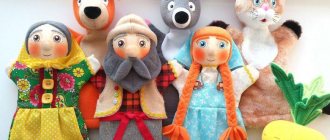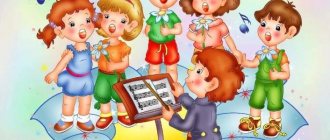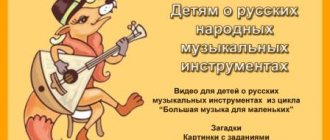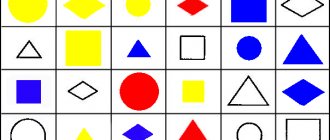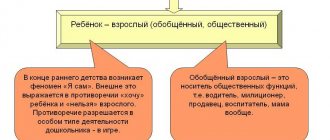Tags: Speech therapy, Development, Speech development
Children tend to have a lisp, not pronounce sounds, skip or replace them with simpler ones. This is due to the imperfection of the articulatory apparatus. Is it possible to fix this problem?
Typical speech disorders in children 5-6 years old
Most older preschoolers have difficulties with:
- mastering sonorous and hissing sounds;
- sound analysis of words;
- development of narrative speech;
- writing a story and descriptions.
Of course, such problems can be minor, only slightly different from the age norm, or serious, up to and including general speech underdevelopment (GSD). It is necessary to contact a speech therapist in any case, but the supportive work of parents at home is also very important.
It is worth noting that regular speech therapy exercises and classes for children 5-6 years old are useful for every child at home, because they help to master literacy faster.
How do you know when it’s time to work on your child’s speech?
Initially, the child learns to pronounce sounds, then to put them into words, then to construct phrases and express thoughts. You should not expect from a two-year-old child impeccably clean pronunciation and beautiful speech, observing genders and cases. In addition, until the age of three, a child will not be able to concentrate on classes for more than 10 minutes.
The optimal age for starting classes for a healthy child is four to five years. By six he should already be able to pronounce sounds correctly and express his thoughts coherently. It is better to correct the pronunciation before the molars grow in.
Classes are needed if:
- the baby pronounces individual sounds incorrectly;
- the child rearranges syllables in words, constructs phrases incorrectly, confuses cases, gender, and numbers;
- “porridge in the mouth”;
- speech is too fast, slurred;
- the child stutters;
- the baby has suffered a birth injury or infectious disease;
- The child was diagnosed with hearing impairment, mild mental retardation, and developmental delay.
Even if you are not going to take your child to a speech therapist on an ongoing basis, it is worth bringing him for a consultation - you will receive recommendations for home activities. It is also advised to show the child to a speech therapist before school, even if there are no obvious problems.
The problem of speech disorders is not always purely speech therapy - sometimes it makes sense to correct pronunciation only after treatment.
Rules for speech therapy classes at home
The success of home lessons depends not only on the availability of the necessary aids and a work plan agreed upon with the speech therapist. The organization of classes itself is very important. Here are a few simple rules that will help you achieve excellent results:
- All speech therapy exercises for children should be carried out regularly, but a little at a time. You shouldn’t try to do articulation gymnastics, play speech games, or fill out a workbook right away. It is better to devote a few minutes to each type of exercise, rather than having a whole “speech therapy day.”
- Do not force them to complete tasks under pressure; educational activities for children should resemble a game. Come up with a simple plot (for example, a journey into the universe of sounds), prepare small prizes (stickers, paper stars), and arrange physical exercises.
- Praise and support the little student if he makes even the slightest progress. Focus on achievements, even small ones, gradually progress will become more and more obvious.
- Find good workbooks for home practice. They should not only be professional in content, but also bright, colorful, and exciting. It is ideal if the tasks have interactive elements (the opportunity to add something, draw something). Such material makes it possible to interest a preschooler and clearly shows him the “path traveled” and success.
- Don't expect instant results, be patient and gentle perseverance. The process of setting, consolidating, and differentiating sounds is complex; it takes months even for experienced speech therapists. Follow the plan and the results will gradually appear.
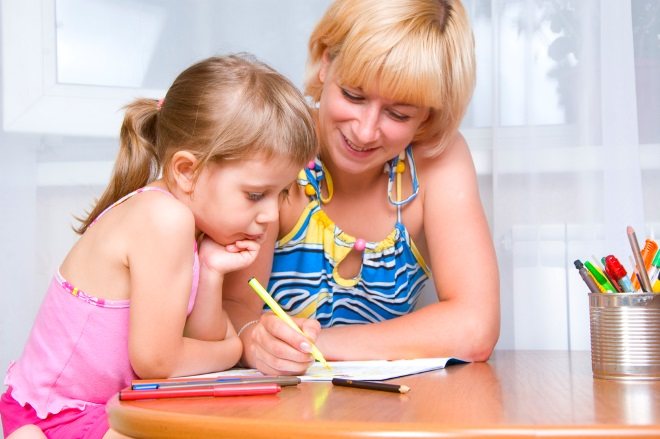
Speech therapy exercises for practicing at home
All speech therapy exercises can be divided into three large blocks, each of which needs to be given attention and carried out regularly:
Development of phonemic hearing
The ability to distinguish sounds by ear seems natural, but if you ask your preschooler to spell a word, you will see gaps.
For children 5-6 years old, there are a large number of special games and exercises that help develop phonemic hearing. These include:
- selection of words starting or ending with a given sound;
- counting sounds in a word, determining the syllable structure;
- drawing up a sound diagram of a word;
- inventing rhymes and short poems;
- pronouncing speeches and tongue twisters.
Thoughtful speech therapy classes for children 5-6 years old make it possible to make all the sounds of their native language obedient and easy.
Finger gymnastics
Fine motor skills of the hands help speech activity, so older preschoolers must do it without fail.
Of course, for children 5-6 years old, the exercises should be complex, with a script, in verse. It is useful to select sets of exercises for both hands at the same time, synchronous. Don't forget to use "helpers":
- small massagers (rubber balls, rollers, cones);
- scissors for cutting;
- plasticine;
- origami paper.
Also remember that all types of needlework, construction, and any creativity are great ways to improve fine motor skills outside of individual lessons.
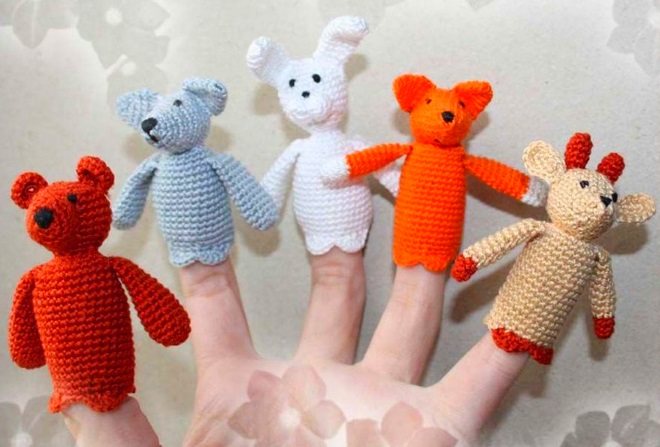
Articulation gymnastics
Special language exercises must be performed every day if there are any problems with pronunciation. For home exercises, it is best to choose a set of exercises with a poetic description and pictures.
Do a tongue warm-up every day, always in front of a mirror (this allows the baby to observe the process himself, assessing its success). If you have problems with one or two sounds, then articulatory gymnastics should be selected for them. These can be found in thematic workbooks on speech therapy.
Features of practicing hissing sounds
To teach a child to correctly pronounce hissing sounds, you must first introduce whistling sounds. If a child in the fourth year of life has learned to pronounce whistling sounds, then there should be no problems with hissing sounds. You can install them with a few simple exercises.
- "Naughty tongue." The child sticks the tip of his tongue out of his mouth. Then he lightly slaps it with his fingers, while saying: “five-five-five.”
- "Delicious jam." The lower lip is pulled down so that the teeth are visible. And the tip of the tongue licks the upper lip, as if it is very sweet there. At the same time, the lower jaw should remain motionless during the exercise.
- “Hide the candy.” Mouth closed. Tighten your tongue and touch your left, then your right cheek. It's like there's candy hiding behind your cheek.
Repeat exercises at least 5 times.
Note! Producing the sounds of native speech is very important for children. It will help them not only make contact with their peers, but also better master the preschool and school curriculum. Parents have the power to help their children avoid difficulties in the future and put the sounds correctly in time.
Speech therapy tasks
Starting with the letter R
One of the most difficult sounds to master is R. Many preschoolers learn to roar loudly by the very end of kindergarten. If the production of the sound P is already behind you, then special exercises will help speed up its automation:
1. “Like a little motor”
We ask the child to pronounce the sound R in the word for a long time, drawlingly (like a motor growls).
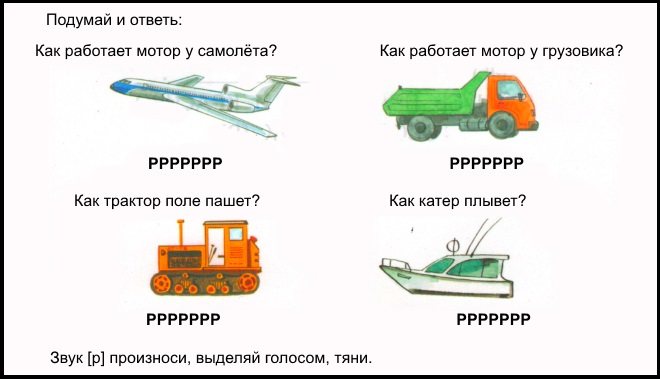
2. “Where is R hiding?” (in pictures and words)
Offer to choose pictures with images of objects with a given sound or clap your hands if he hears such a word.
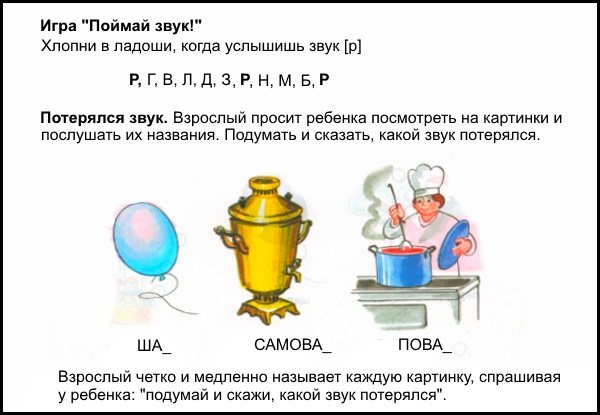
3. “How can you growl?”
Show your child pictures of objects that have the sound r in their names. Offer to read and color the picture.
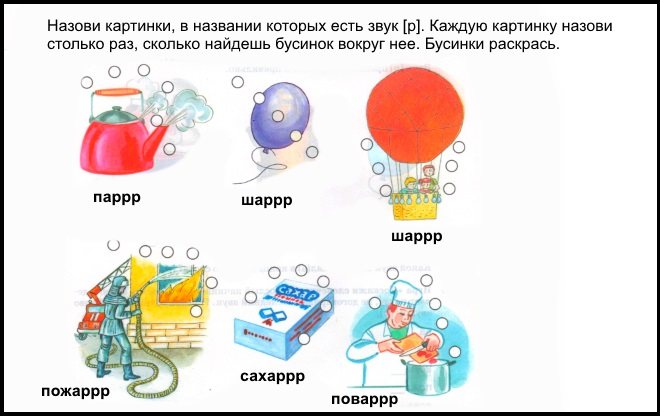
4. “Sounding tracks”
Together with your child, come up with several chants made up of several syllables:
Ra-ra-ra - they ran away from the yard.
Ro-ro-ro - and they found a bucket.
Ru-ru-ru - we came up with a game.
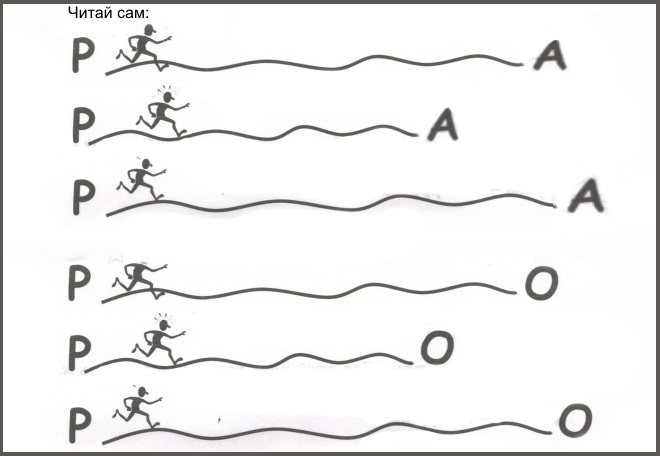
5. “Substitute a syllable”
The adult offers the child words that end or begin with a syllable with P (ra, ro, ry), the child must choose the correct option and pronounce it correctly.

6. “Look and name”
An adult asks the child to read words with the letter r from the pictures. The word must be said as many times as there are stars next to each picture.
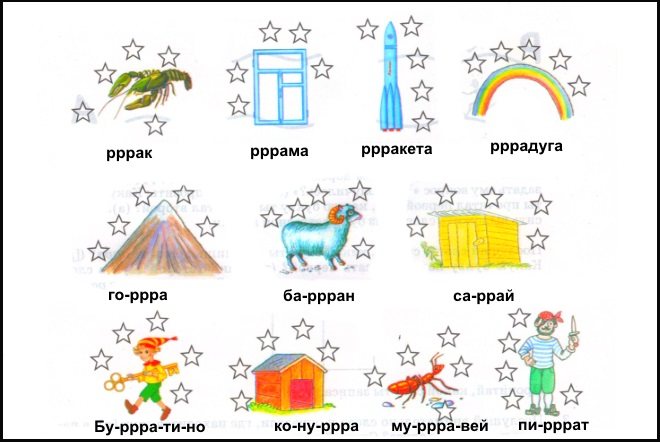
7. “Poems, tongue twisters, riddles”
Learn with your child several poems and riddles in which words with R appear.
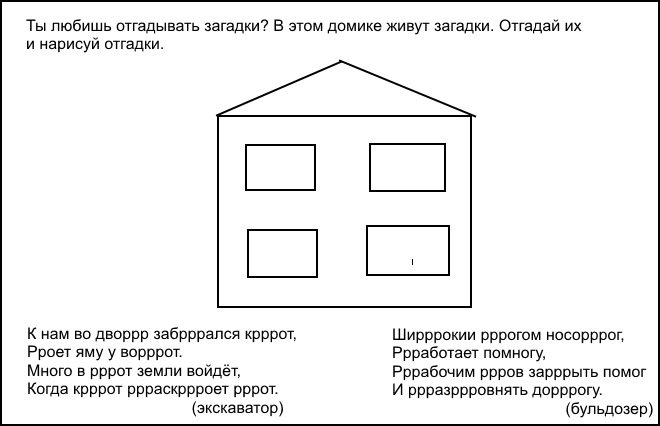
The necessary tasks for speech development can be found in the Workbook for the sound R, compiled by Kostyuk A.V.
Download, print the tasks in pictures and study at home:
Speech therapy tasks for the letter P
Starting with the letter L
The hard sound L is also often difficult for children 5-6 years old. If the baby has already learned to pronounce it alone, in isolation, then it’s time to start working on automation in speech. The following exercises are suitable for this:
1. “Say it nicely”
Offer your child several images of words starting with L. Ask him to pronounce the words beautifully, emphasizing the desired sound with his voice.

2. “Toys for Larisa”
Ask your child to collect gifts for the Larisa doll. Tell her that she only likes things that begin with L. For this exercise, you need to select small objects or pictures in advance; all words should not begin only with L.
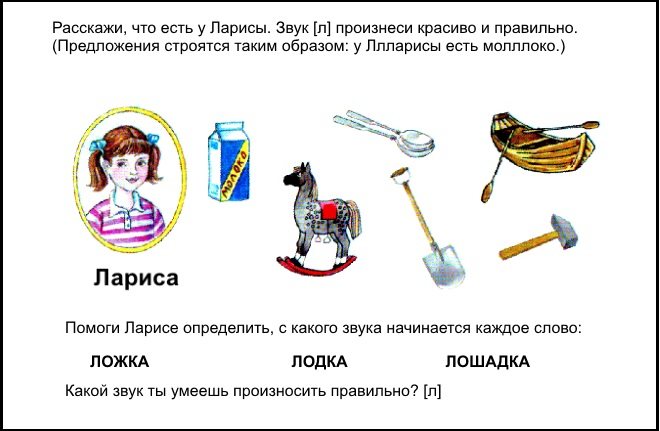
3. “One-many”
Invite your child to name words with L in the singular and plural. In the workbook for the sound L (author Kostyuk A.V.) there is a whole table with pictures for this exercise (lesson 20).
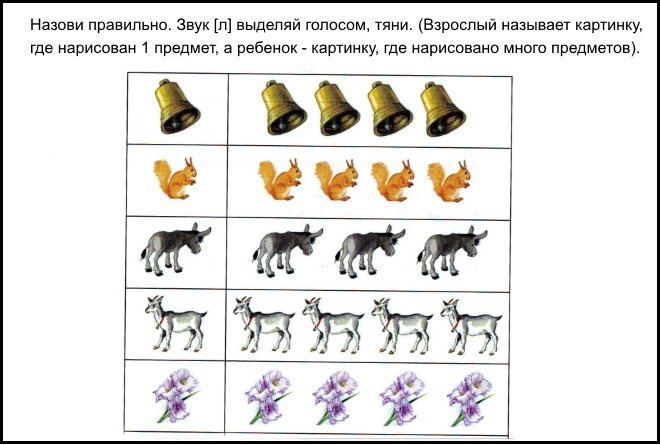
4. “Find the Sound”
Invite your child to draw up a diagram of the word and mark the place L on it. If it is still difficult for your child to independently determine the number of sounds, then first you can do several similar exercises from the workbook.
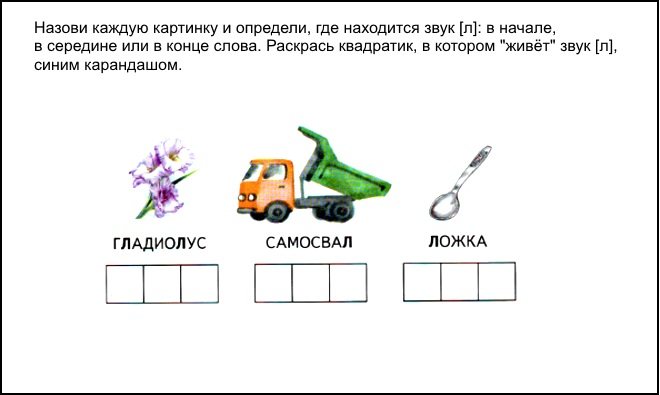
5. “Tongue twisters and nursery rhymes”
Use nursery rhymes, tongue twisters and poems with words that contain L.
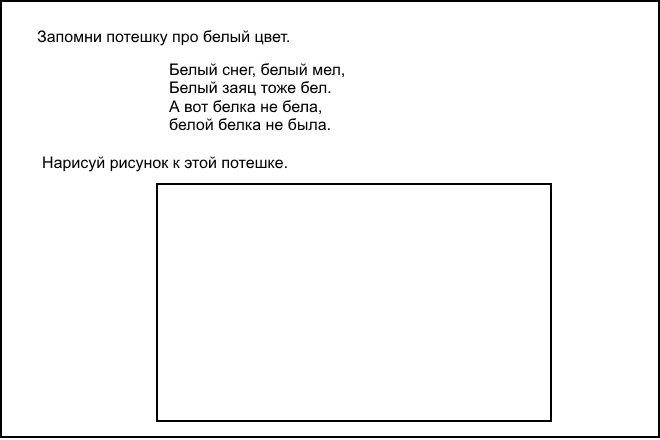
Download and print tasks in pictures starting with the letter L:
Speech therapy tasks for the letter L

